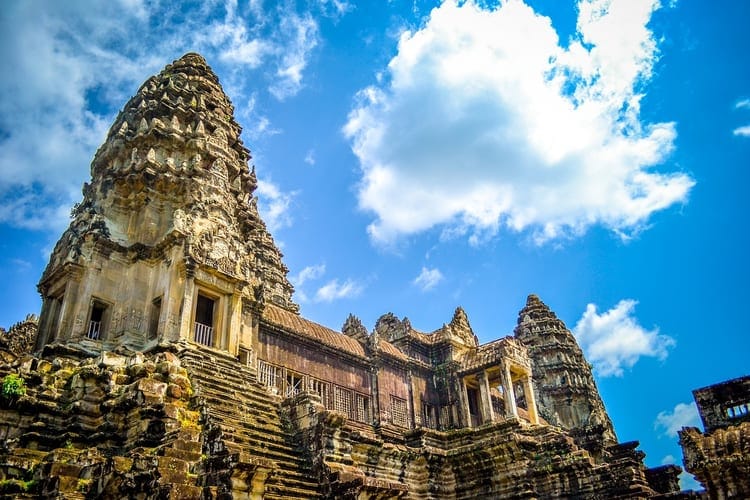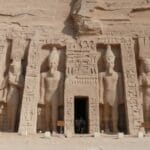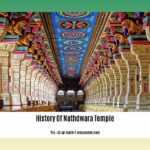Welcome to the captivating world of Angkor Wat, Cambodia’s ancient architectural marvel that has left the world in awe for centuries. Get ready to dive into its rich history, intriguing secrets, and stunning features that have earned it a spot as a UNESCO World Heritage Site. Let’s explore the wonders, mysteries, and fascinating trivia that make this Cambodian treasure a must-see:
Angkor Wat Fun Facts
Ready to have your mind blown by some epic facts about Angkor Wat? Buckle up because this ancient temple complex is bursting with history, mystery, and architectural wonders.
- Seriously, size does matter! Imagine a temple complex so enormous it could swallow up a small city. That’s Angkor Wat, sprawling over a mind-boggling 402 acres, making it the world’s largest religious monument. We’re talking bigger than Disneyland!
- They didn’t have power tools back then! Get this – Angkor Wat took a whopping three decades to build. That’s right, three full decades with over a million skilled workers meticulously placing each stone. Talk about dedication!
- It’s like a giant stone storybook! Angkor Wat is way more than just a pretty face. It’s a visual representation of Mount Meru, the sacred mountain in Hindu mythology believed to be the center of the universe and home to the gods.
- From Hindu haven to Buddhist sanctuary: Originally, Angkor Wat was dedicated to the Hindu god Vishnu. However, as time went on and the beliefs of the Khmer people shifted, the temple gradually embraced Buddhism, showcasing the evolution of faith.
- Did someone say stargazing? Some scholars believe that Angkor Wat might have been more than just a temple. They suggest its alignment with certain celestial events hints at a possible astronomical observatory.
- Ancient engineers knew their stuff! They didn’t have fancy plumbing back then, but that didn’t stop the geniuses behind Angkor Wat. They crafted an ingenious network of canals and reservoirs, demonstrating their advanced engineering prowess.
- The case of the missing king! Imagine a real-life treasure map hidden within the temple walls. The final resting place of King Suryavarman II, the ruler behind Angkor Wat, remains a tantalizing mystery for archaeologists.
- Carvings that could tell a thousand tales! Prepare to be mesmerized by Angkor Wat’s intricate carvings. They depict captivating scenes from Hindu mythology and Cambodian history, offering a glimpse into the rich tapestry of the Khmer civilization.
- A global treasure! It’s no surprise that Angkor Wat has earned its place as a UNESCO World Heritage Site. Millions of visitors flock here each year to experience its grandeur firsthand.
- Still inspiring awe today: Centuries later, Angkor Wat continues to captivate and inspire. It embodies the heart and soul of Cambodia, serving as a testament to the nation’s architectural brilliance and enduring legacy.
What Makes Angkor Wat Special?
Why is Angkor Wat such a big deal? Imagine a temple complex so vast it feels like a miniature city – that’s Angkor Wat. This isn’t just some random collection of stones; it’s an architectural and spiritual marvel sculpted with incredible detail.
Think about this: Angkor Wat sprawls over a whopping 402 acres. To put that into perspective, that’s larger than hundreds of football fields combined! It’s officially the largest religious monument ever built, a testament to the ambition and artistry of the Khmer Empire.
The entire temple is a symbolic representation of Mount Meru, the sacred mountain at the heart of Hindu cosmology. Imagine the Khmer architects saying, “We’re recreating the universe!” This deep spiritual connection elevates Angkor Wat from a mere building to a powerful symbol of faith.
And let’s not forget the sheer architectural genius on display. The intricate carvings that seem to dance across the walls, the perfectly aligned towers reaching for the heavens, the mind-boggling hydraulic systems – these were people who were seriously ahead of their time. Some scholars even suggest that techniques used in Angkor Wat’s construction might have been lost to time, making it even more remarkable.
Speaking of time, Angkor Wat has seen a lot of it. This wasn’t just some forgotten relic; it was the beating heart of the Khmer Empire, built by King Suryavarman II in the 12th century. It served as a reminder of his power and the spiritual center of his reign. Walking through those ancient corridors is like taking a step back in time.
But Angkor Wat isn’t stuck in the past. It’s a beautiful blend of Hindu and Buddhist influences, showing how the exchange of ideas and beliefs shaped the region. It’s a testament to the power of cultural fusion and a reminder that even across vast distances and time, we’re all connected.
Today, Angkor Wat isn’t just a temple; it’s the soul of Cambodia. It’s on their flag, a source of immense national pride, and a powerful reminder of their rich cultural heritage. It draws visitors from all corners of the globe, all united in awe of this architectural marvel.
What are 5 facts about Cambodia?
Let’s uncover some seriously cool facts about Cambodia, a country bursting with ancient secrets and a dazzling culture:
1. Angkor Wat: It’s HUGE!
Get ready to have your mind blown, because Angkor Wat isn’t your average temple. This place is massive! It’s actually the largest religious monument in the world, sprawling over an area bigger than the Vatican City and even the Great Pyramids of Giza. Imagine walking through a city of intricate carvings, towering temples, and hidden courtyards – that’s Angkor Wat! Built by the ancient Khmer civilization, it’s no wonder this place is a UNESCO World Heritage Site.
2. Siem Reap: Your Adventure Starts Here
Think of Siem Reap as the starting point for your Cambodian adventure, especially if you’re eager to see Angkor Wat. This town is buzzing with energy – it’s where ancient ruins meet modern life. More than half of all the tourists who visit Cambodia pass through Siem Reap. Why? It’s the perfect basecamp for exploring the temples and soaking up the historical vibes.
3. Angkor Wat: Cambodia’s Pride and Joy
Angkor Wat isn’t just an architectural masterpiece; it’s a symbol of national pride for Cambodians. How much pride? Well, it’s featured right on the Cambodian flag! It’s one of only two national monuments in the world to receive this honor (the other is on the flag of Afghanistan). That tells you just how important this temple is to Cambodia’s identity and heritage.
4. The Khmer Empire: Architects of Wonder
From the 9th to the 15th centuries, the Khmer Empire ruled over a large part of Southeast Asia. These guys were incredible builders, and Angkor Wat is like their biggest claim to fame. But it’s not just the size of their buildings that impresses; it’s the intricate details, the religious symbolism, and the sheer scale of their ambition. The Khmer Empire left behind a legacy that continues to astound people from all corners of the globe.
5. A Cultural Tapestry: Influences from Near and Far
Cambodian culture is like a vibrant tapestry woven from different threads. You’ll see influences from Khmer traditions, of course, but also hints of Indian and Chinese culture in the art, music, dance, and even the food. It’s this blend of influences that makes Cambodia so unique and captivating. Whether you’re admiring the elaborate carvings of Angkor Wat or browsing through colorful Khmer textiles, you’ll feel the richness and depth of Cambodian culture.
What is Angkor Wat best known for?
Angkor Wat’s majestic beauty and sheer scale make it a popular destination. It’s a sprawling testament to the architectural genius and deep spirituality of the Khmer civilization. Imagine a temple complex so vast it covers over 400 acres – that’s bigger than some towns!
What makes it so special? Imagine soaring towers arranged like a constellation against the sky, intricate carvings that seem to whisper stories of ancient myths and legends, and a network of chambers and galleries that feel like pathways to another world.
The Khmer architects didn’t just throw up some buildings; they were aiming for the heavens, literally. Angkor Wat is designed to represent Mount Meru, the sacred mountain in Hindu mythology where the gods reside.
But it wasn’t just about religion. Angkor Wat was the beating heart of the Khmer Empire, a symbol of their power and prosperity. Kings would have ruled from here, surrounded by the grandeur that solidified their divine right.
Today, Angkor Wat stands as a proud symbol of Cambodia, its iconic towers gracing everything from the national flag to countless souvenirs. People travel from every corner of the globe to witness its splendor, making it one of the most visited archaeological sites in the world.
While we can marvel at its beauty and delve into its history books, there’s still an air of mystery clinging to those ancient stones. Archaeologists and historians are constantly unearthing new clues, refining their understanding of how it was built, how it was used, and what really went on within its walls. Every discovery adds another layer to the story, making Angkor Wat not just a monument to the past, but a living, breathing testament to human ingenuity.
Is Angkor Wat a 7 Wonder of the World?
You might be surprised to learn that Angkor Wat, while absolutely breathtaking and historically significant, isn’t officially recognized as one of the “New7Wonders of the World.” This list came out in 2007 after people worldwide voted for their top picks, and it includes amazing places like the Great Wall of China and the Taj Mahal. But even though Angkor Wat didn’t make that list, it’s still a total must-see that wows everyone who visits with its sheer size, incredible details, and rich history.
Think about this: Angkor Wat is the biggest religious structure on the planet. It covers more than 400 acres—that’s bigger than a lot of towns! Built way back in the 12th century, it was designed as a Hindu temple to honor the god Vishnu. The builders used sandstone and laterite (a type of reddish rock) to create mind-blowing carvings, sculptures, and those intricate scenes you see etched into the walls (those are called bas-reliefs).
It’s no wonder that UNESCO, the organization that protects important cultural sites, named Angkor Wat a World Heritage Site back in 1992. And even though the Khmer Empire, which built Angkor Wat, isn’t around anymore, this awe-inspiring temple still draws millions of visitors every year.
What is a fun fact about Angkor Wat?
We’ve talked about how massive Angkor Wat is, but did you know it might actually be a giant compass? The entire temple complex seems to be carefully lined up with the cardinal directions – north, south, east, and west. This isn’t just some random coincidence either.
People back then were really into astronomy. They believed that by aligning their buildings with the stars and planets, they could tap into cosmic power. This suggests that the Khmer architects who built Angkor Wat were probably very knowledgeable about the night sky. They might have even used the stars to help them lay out the temple’s foundations!
Of course, we can’t be 100% sure about all this. A lot of the ancient Khmer knowledge has been lost over time. But the idea that Angkor Wat was designed as a grand astronomical observatory is pretty mind-blowing.
What is the mystery of Angkor Wat?
Angkor Wat is also shrouded in mystery. This UNESCO World Heritage Site is like a giant puzzle, and historians and explorers are still trying to put all the pieces together:
- Architectural Enigma: Have you ever looked at a building and wondered, “How on earth did they build that?” Well, that’s how people feel about Angkor Wat. Its design is crazy intricate, and the sheer size of it is mind-blowing. We’re talking about a massive complex built centuries ago by the Khmer Empire, and even today, experts are amazed by their architectural skills.
- Hidden Passages and Chambers: There are whispers (literally and figuratively) of secret tunnels and hidden rooms within Angkor Wat. Some people think these were used for religious ceremonies, while others believe they might hold lost treasures. Imagine being the one to discover what’s behind those hidden doors!
- Astronomical Alignment: Ever heard of a building being used as a giant calendar? Some researchers think Angkor Wat might be just that. They believe its layout aligns with certain stars and celestial events. It’s like the Khmer Empire built a giant astronomical clock right into their architecture.
- Lost City of Angkor: Angkor Wat wasn’t always standing alone in the jungle. It was actually part of a huge, bustling city called Angkor Thom. Today, we only have the ruins scattered throughout the Cambodian jungle to give us clues about this once-thriving civilization. What happened to them? That’s one of the biggest mysteries of Angkor.
- Sacred Symbolism: Every nook and cranny of Angkor Wat seems to have a deeper meaning. From the towering spires to the intricate carvings, everything is packed with symbolism connected to the Khmer people’s spiritual beliefs. It’s like trying to decipher a giant, ancient code.
- Unexplained Phenomena: This is where it gets really interesting. People who visit Angkor Wat often report experiencing strange things – weird sounds, fleeting shadows, and an overall feeling of something mystical. Whether it’s just their imagination or something more, these unexplained events add to the mystique of Angkor Wat.
The best part about mysteries is that they keep us guessing. There’s still so much we don’t know about Angkor Wat, and that’s what makes it so fascinating. New discoveries are being made all the time, and who knows what other secrets this ancient wonder holds? Perhaps one day, you’ll be the one to finally solve the mysteries of Angkor Wat!
What is unusual about the Angkor Wat temple?
Several things make Angkor Wat stand out, even among the other incredible temples in the area:
- Facing the Setting Sun: Most temples in Angkor face east to welcome the sunrise, but Angkor Wat faces west, which lines up with the Hindu idea of Mount Meru, a sacred mountain, being in the west. This has led some experts to believe that Angkor Wat might have been built as a special kind of tomb for King Suryavarman II, connecting his passing with the journey to the west.
- Stars in Alignment: The more we learn about Angkor Wat, the more impressive it becomes. The towers of the temple aren’t placed randomly; they point towards specific positions of the sun during important astronomical events like the spring equinox. This shows just how skilled the Khmer architects were. They knew the skies like the backs of their hands, weaving this knowledge into the temple’s design. It’s like they built a giant calendar in stone!
- A Living Temple: Many ancient temples were abandoned, but Angkor Wat has been a sacred space for centuries, from its beginnings as a Hindu temple dedicated to Vishnu to its later role as a Buddhist sanctuary. Even today, monks and worshippers still come to Angkor Wat, showing its enduring spiritual significance.
- A Place of Continuous Life: Unlike other temples in the Angkor complex that were mostly abandoned by the 16th century, Angkor Wat continued to be a living place. Japanese Buddhist pilgrims were drawn to its beauty and serenity, making it a place of pilgrimage and creating a small community within its walls. This constant human presence, a continuous thread connecting the past to the present, makes Angkor Wat even more special.
Want to Learn More?
- Check out “Mysteries of Angkor Wat” on the History Channel website for more fascinating insights into this incredible temple.
Why do people like to visit Angkor Wat?
Have you ever wondered why Angkor Wat is such a popular spot?
Picture this: a massive temple complex, the biggest of its kind anywhere in the world. That’s Angkor Wat! Built way back in the 12th century, it was originally dedicated to the Hindu god Vishnu and later transitioned into a place of Buddhist worship. This blend of religions reflects Cambodian history and spirituality.
But it’s not just the size or history – the details are breathtaking. Imagine intricate carvings covering almost every surface, stories etched in stone that bring ancient myths and legends to life. These intricate designs, along with the towering spires and expansive courtyards, showcase Khmer architecture.
For many, though, Angkor Wat is more than just a tourist attraction – it’s a deeply spiritual place. The atmosphere has a stillness, a serenity that draws in both Hindus and Buddhists seeking a connection with something larger than themselves.
And then there’s the history. Walking through Angkor Wat is like stepping back in time. The bas-reliefs, those incredible carvings, are more than just pretty pictures. They offer a glimpse into the daily life, the stories, and even the historical events of the Khmer civilization.
No wonder UNESCO named Angkor Wat a World Heritage Site! It’s a place where architectural genius meets cultural significance, where history unfolds before your eyes, and where a sense of peace seems to settle upon you.
What is the astronomical significance of Angkor Wat?
Let’s delve deeper into Angkor Wat’s astronomical connections. The whole complex, built way back in the 12th century, seems to be laid out with the stars in mind. We’re talking about alignments with celestial events, like solstices and equinoxes.
The central tower, a towering representation of Mount Meru, is positioned just so. During the spring and autumn equinoxes, the sun rises directly over this tower. Coincidence? Probably not.
This careful alignment suggests that Angkor Wat wasn’t just a place of worship but might have also served as a giant astronomical observatory. Imagine the Khmer priests using the temple’s layout to track the movements of the sun, moon, and stars, marking important dates and guiding their religious ceremonies.
This blend of architectural grandeur and astronomical know-how speaks volumes about the Khmer builders. By incorporating the movements of the heavens into their design, they created a space where the earthly and the cosmic intertwined, reflecting their deep understanding of the universe and their place within it.
Think about it: these ancient architects, without the fancy telescopes and computers we have today, were able to create a structure so closely aligned with the cosmos.
While we can’t say for sure how they used this knowledge, some experts believe that Angkor Wat’s astronomical alignments played a crucial role in their calendar system, religious rituals, and even agricultural practices.
Much about Angkor Wat remains shrouded in mystery. Ongoing research continues to uncover new insights into its many secrets, and it’s entirely possible that our understanding of its astronomical significance will evolve as we learn more.
So, the next time you see a picture of Angkor Wat, remember that it’s not just a beautiful temple. It’s a testament to human ingenuity, a giant astronomical puzzle, and a window into the beliefs and practices of a fascinating ancient civilization.
How impressive is Angkor Wat?
Angkor Wat is a sprawling complex of temples, reflecting pools, and intricate carvings that sprawls over 402 acres. To put that into perspective, it’s about four times the size of Vatican City!
A Monument to Khmer Might:
Imagine being a visitor approaching Angkor Wat during the height of the Khmer Empire. The sight of this massive temple complex rising from the jungle would’ve been absolutely breathtaking – a powerful symbol of the empire’s wealth and influence. It’s no wonder that Angkor Wat became the heart of Khmer civilization, a place of pilgrimage, political power, and incredible artistic achievement.
Stars and Stones:
Researchers believe that the layout of Angkor Wat isn’t random. Instead, it probably aligns with specific celestial events, like solstices and equinoxes. This suggests that the Khmer architects and astronomers possessed a deep understanding of the stars and their movements. They may have even used their knowledge to create calendars and schedule important religious ceremonies.
Stories in Stone:
One of the things that makes Angkor Wat so captivating is the sheer amount of detail carved into practically every surface. Imagine walking for hours, surrounded by walls covered in scenes from Hindu mythology – epic battles between gods and demons, stories of creation, and glimpses of everyday life in the Khmer Empire. These carvings aren’t just beautiful; they’re like a visual encyclopedia, providing us with invaluable insights into the beliefs, stories, and daily routines of a civilization long gone.
The Mystery Continues:
Even today, archaeologists are making new discoveries, uncovering hidden chambers, deciphering ancient inscriptions, and piecing together the complex puzzle of Angkor Wat’s past. There’s still so much we don’t know, and that’s part of what makes it so alluring. Visiting Angkor Wat isn’t just a trip back in time; it’s a journey into the heart of a civilization that continues to amaze and intrigue us centuries later.
Ready for More Adventures?
Want to explore other fascinating cultures and historical wonders? Check out these captivating articles:
- Explore the intriguing 10 facts about the Mayans that will captivate your mind.
- Discover the untold 16 true facts about Laura Ingalls Wilder that will paint a vivid picture of the pioneer life.
- Unleash the thrilling 1969 Camaro Z28 facts and immerse yourself in the world of muscle cars.
















